Lovely Whitby is a seaside town in North Yorkshire, England with just about everything you can ask for from a coastal break; gorgeous sandy beaches, a picturesque harbour, loads of history and lots of things to do. Read on for the best things to do in Whitby.
Is it worth visiting Whitby?
I’ve been visiting Whitby since I was little and it’s probably my favourite seaside town in the UK. I visited again recently and found Whitby just as great as ever.
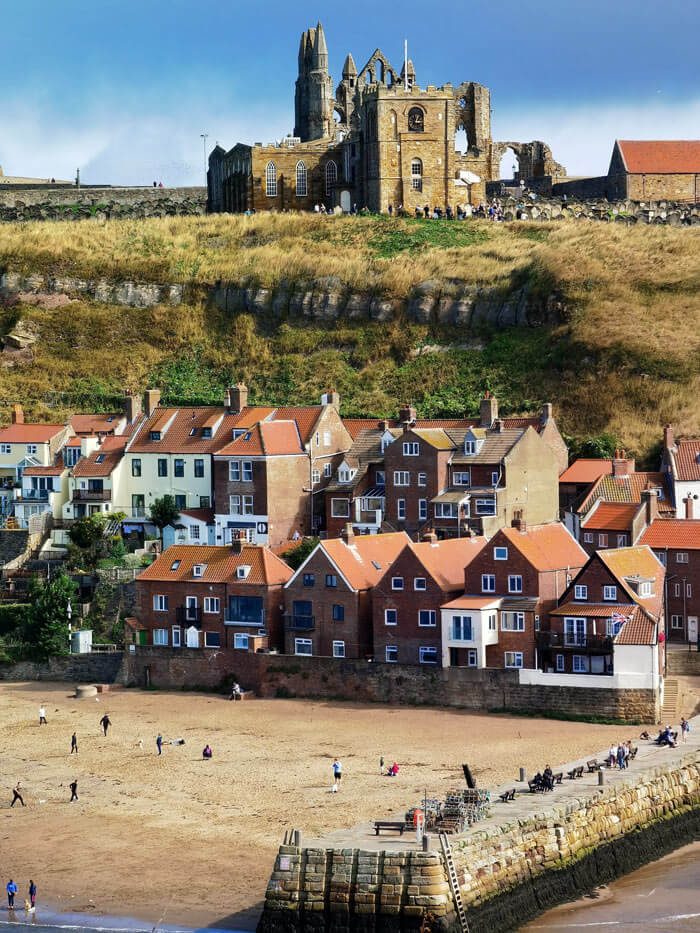
Whitby is absolutely worth visiting as it has much more than your average seaside town – there’s an amazing abbey that features in Dracula, a wonderfully scenic steam railway and an increasingly exciting food and drink scene. There are so many things to do in Whitby that it’s well worth making a weekend of it.
What is Whitby known for?
Whitby is most famous for its connection to Dracula, the classic vampire novel by Bram Stoker. In the novel, Dracula arrives in England on board a ship which runs aground on the Yorkshire coast. A large dog-like creature jumps from the wreck and bounds the 199 steps up to Whitby Abbey, beginning Dracula’s reign of terror in England.
Bram Stoker visited Whitby in the summer of 1890 and was very taken with Whitby Abbey, which looms over the town, and also the weathered gravestones in the churchyard of St Mary’s parish church. Stoker also went to the public library and there read a history of Romania which mentioned the bloodthirsty 15th century prince Vlad Tepes also known as Dracula.
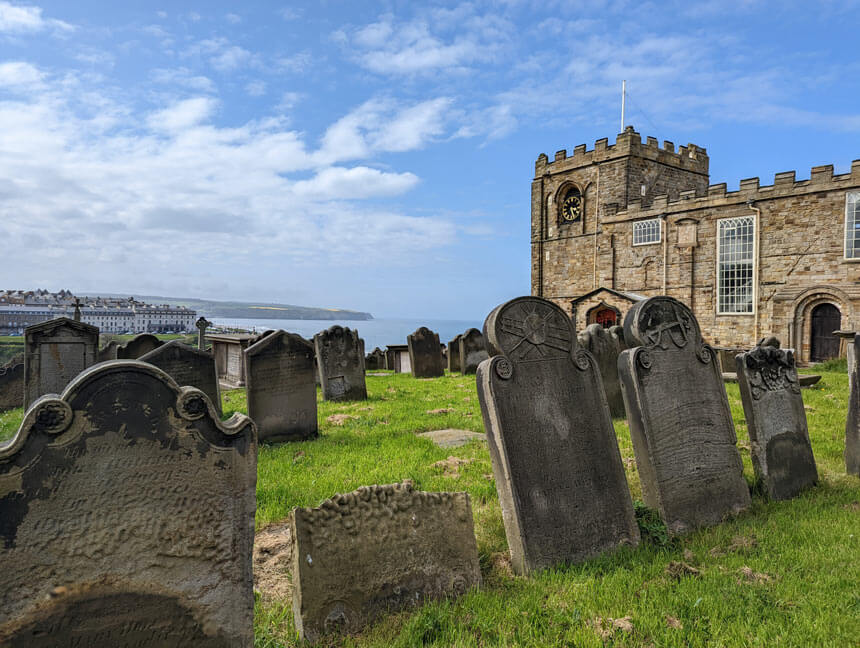
While visiting Whitby, it seems likely that Stoker would have heard about a ship that had run aground on the beach below the abbey just five years earlier. Visiting Whitby was clearly very inspiring for Bram Stoker – who knows whether it would have been written at all if he had gone somewhere else on holiday!
Things to do in Whitby
Climb the 199 steps
The two top things to do in Whitby go together; climb the 199 steps from Church Lane up to St Mary’s church and Whitby Abbey. Nobody really knows how old the 199 steps are, but they date back to at least 1340.
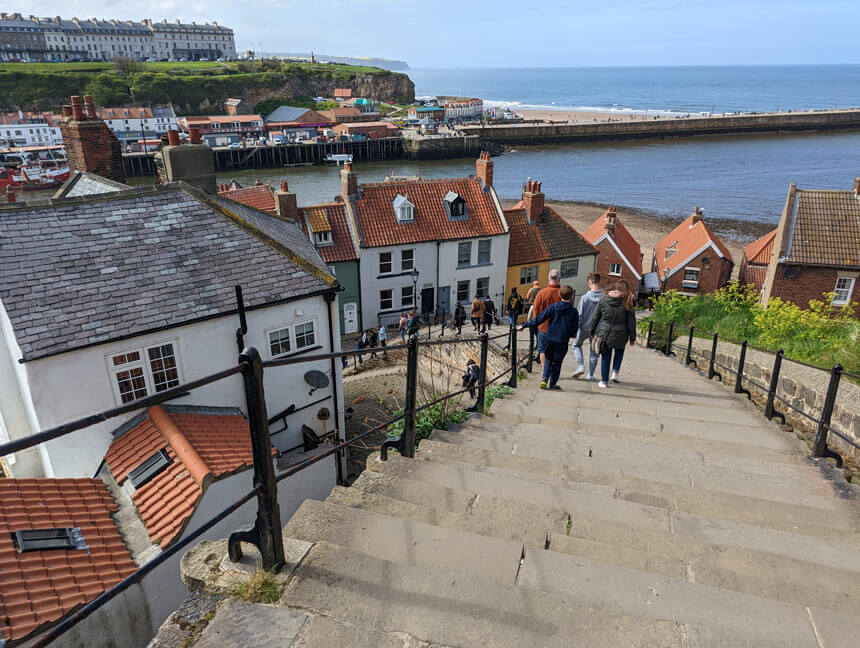
If you’re able to, climbing the 199 steps is a must-do when you’re visiting Whitby. The views over the town, the harbour and the sea are absolutely stunning, and the climb does sound worse than it is. The steps are pretty wide and there are a number of places to stop and either admire the view or catch your breath on the way up. If you’re not able to climb the steps, don’t worry; the Whitby hop-on hop-off bus will take you to the abbey. The top of the 199 steps is by St Mary’s church, just a short, gently sloping walk down from the Abbey car park.
It’s free to climb the 199 steps; no wonder then that it’s one of the most popular things to do in Whitby.
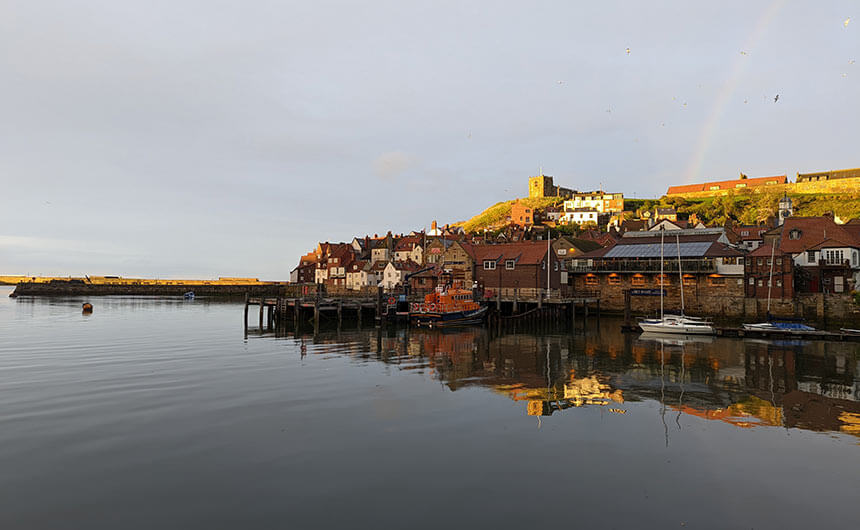
Visit Whitby Abbey
After you’ve climbed the 199 steps, you should visit the abbey. Visiting Whitby Abbey is absolutely one of the best things to do in Whitby, and this site is one of the most historic in the north of England. The ruins you see today are around 700 years old, but there has been a settlement here on Whitby’s headland for around 3000 years.
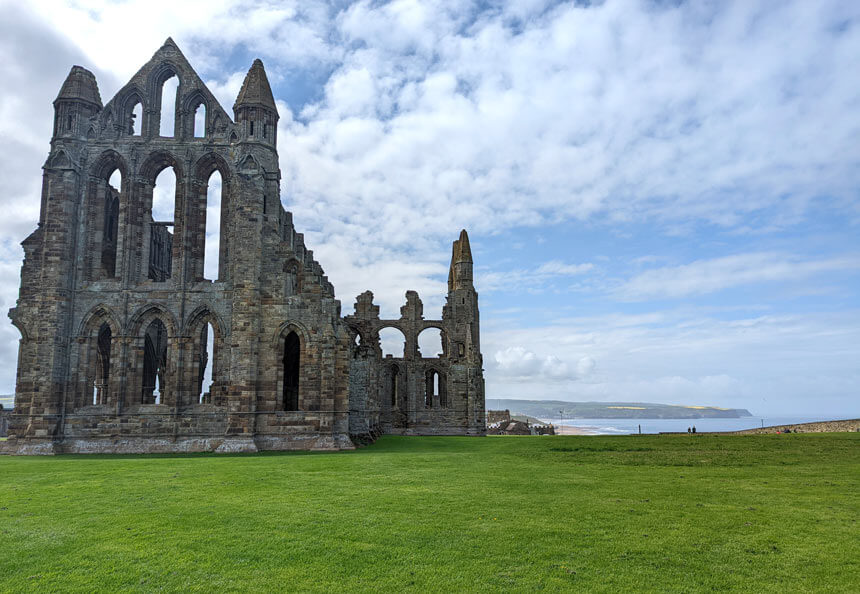
Excavations have found evidence of a Bronze Age roundhouse, and it’s likely that the Romans had a signal station here. After the Romans left, Britain was ruled by multiple small kingdoms; one of the most powerful, Northumbria, covered most of the north east corner of England. The king of Northumbria converted to Christianity in the 7th century, and shortly afterwards a monastery was founded on the headland.
The site was abandoned sometime in the 9th century, probably because of Danish raids, but a Benedictine monastery was re-founded here in 1078, and the buildings that stand today were built around 200 years later, in 1225-50.

The Abbey was dissolved, along with almost all other monasteries in England, by King Henry VIII in the 1500s. The buildings gradually decayed over the centuries, and a German bombardment in 1914 severely damaged one of the remaining walls. In 1920, the owners of the land handed the Abbey ruins over to the nation.
Today, Whitby Abbey is owned and run by English Heritage, the same organisation that looks after Stonehenge and over 400 other historic sites. Before you buy your tickets for Whitby Abbey, it’s well worth taking a look at the list of sites to see if there are others that you might want to visit. If there are, you should consider an English Heritage pass (if you’re visiting Whitby from overseas) or English Heritage membership, (if you live in the UK). Either of these will give you free admission to any English Heritage site for as long as your pass or membership lasts.
Until 31 July 2023 you can save 15% on a new annual direct debit or gift English Heritage annual membership with the code EHAFF2023.
There are quite a few English Heritage sites near Whitby; Scarborough Castle, Pickering Castle and Helmsley Castle are all great places to visit and buying a pass means you can save a lot on entry fees.

When you visit Whitby Abbey you’ll enter at the gatehouse. You’ll be given an audio guide (included in the ticket price) and from there you’re free to explore the ruins, finding out about the history of the Abbey as you go. The best-preserved part of the Abbey is the Sanctuary and Presbytery, but it’s all very beautiful and there are gorgeous views over the town. It’s not difficult to imagine why visiting Whitby Abbey so inspired Bram Stoker.
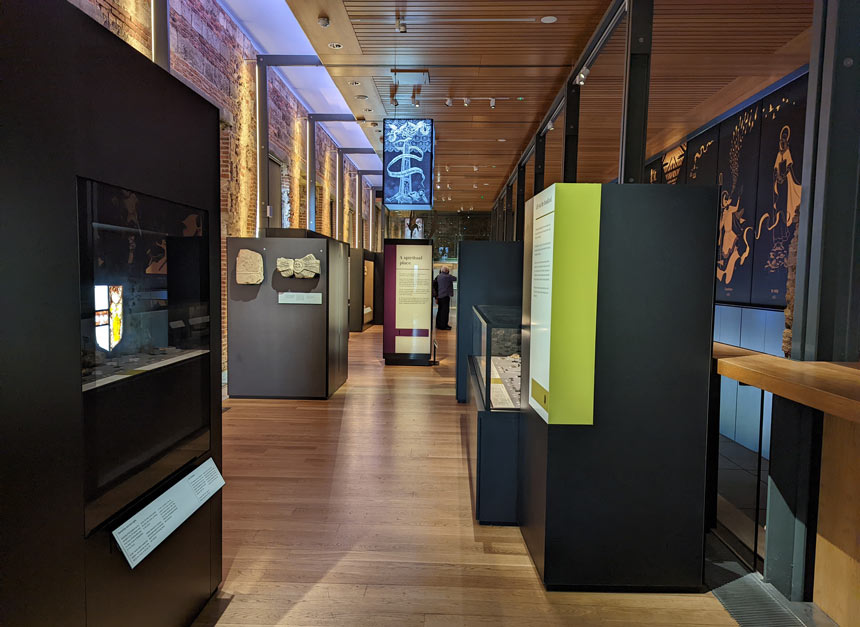
After you’ve explored the ruins, you can visit the visitor centre, set in a grand country house which belonged to the family who bought the site after the monastery was dissolved. The exhibition in the visitor centre is very interesting and you also can see relics from the site’s history.
Eat fish and chips
By now you’ll have worked up an appetite, so it’s time to try another of the best things to do in Whitby; eat fish and chips. There are loads of fish and chip shops in Whitby but the most popular one by far is the Magpie Cafe on the harbour front – you’ll know it by the queue outside!
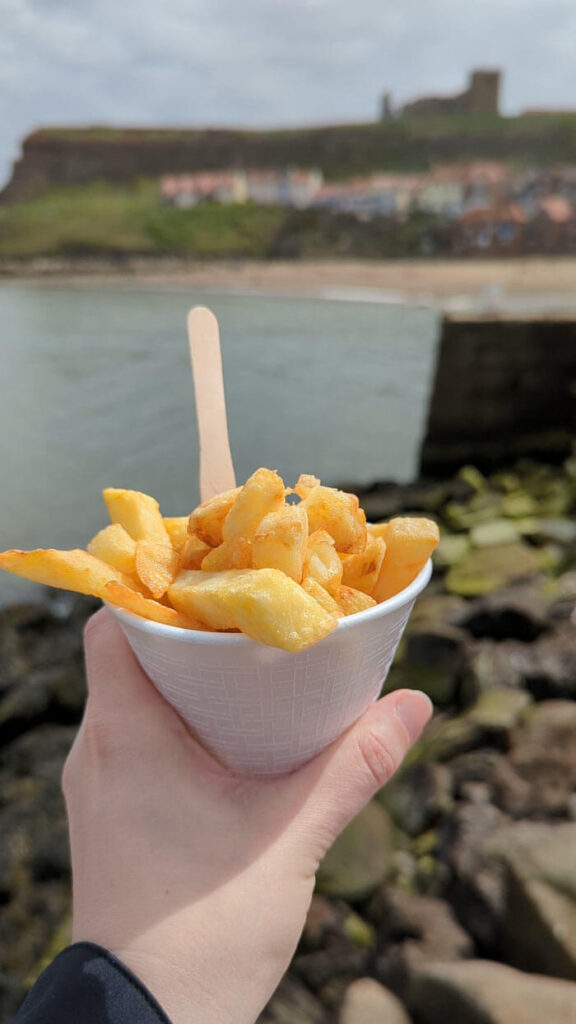
Lots of fish and chip shops have seating inside, but unless it’s raining, chips always taste better eaten outside – just make sure you watch out for the thieving seagulls.
Have a lemon top ice cream
After you’ve had your fish and chips, you might be in the mood for something sweet, so get yourself a lemon top ice cream. While you can get this delicious combination of vanilla ice cream and lemon sorbet elsewhere on the Yorkshire coast, you’ll see them everywhere in Whitby.

Go to the beach
No trip to Whitby is complete without setting foot on one of the lovely sandy beaches. There are four beaches in Whitby; three small beaches at the foot of the headland, where you’ll find the Abbey and the old part of town. On the other side of the river, Whitby’s main beach is at the foot of the West Cliff.
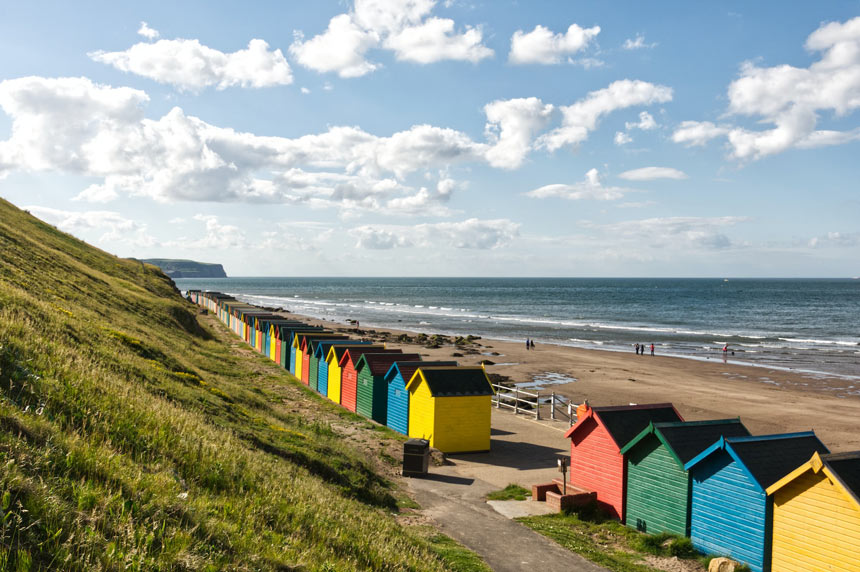
Visiting the West Cliff beach is one of the top things to do in Whitby, whatever time of year you visit. In the summer it’s perfect for building sandcastles, while in the colder months you can still enjoy a bracing walk to blow the cobwebs away, then warm up afterwards with a hot drink from the (very accidentally Wes Anderson) Clara’s cafe.
Go hunting for Whitby jet
While you’re on the beach, keep your eyes peeled for Whitby jet, a black gemstone made of fossilised Araucaria tree wood that fell 180 million years ago. Queen Victoria was a big fan and often wore jet jewellery after the death of her husband Prince Albert.
However not every black stone on Whitby’s beaches is jet – there’s also a lot of coal! You can tell whether the rock you’ve found is jet or coal by rubbing a corner against a light-coloured rock. If the mark it leaves is black, you’ve found coal. If the mark is light brown, then congratulations, you’ve found jet!
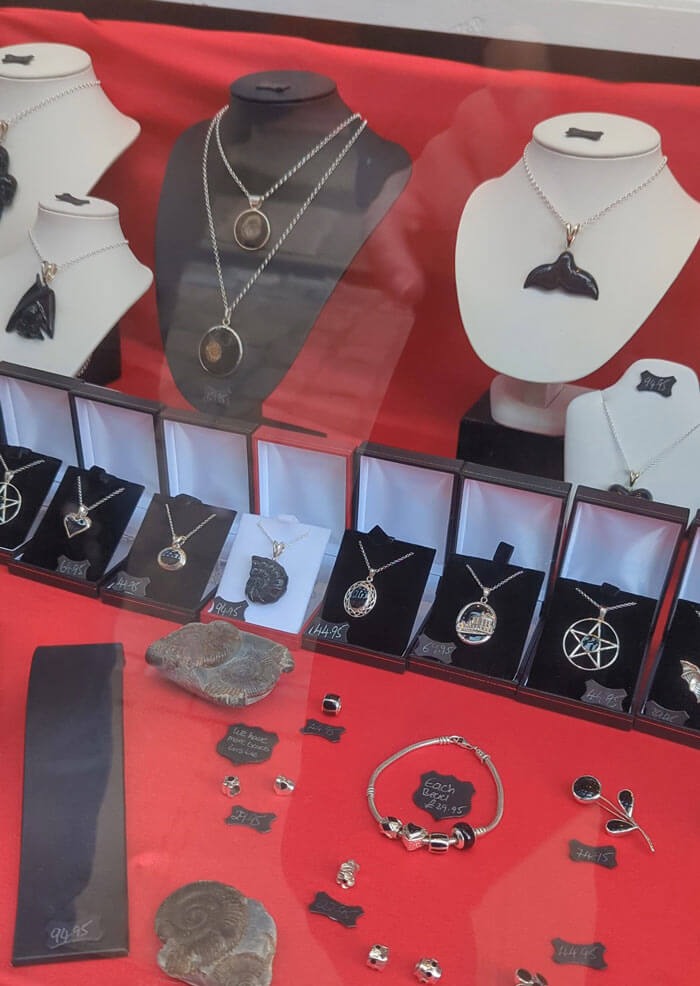
If you’re not lucky enough to find your own piece of jet, there are lots of shops in the old part of town where you can buy jet jewellery. The Museum of Whitby Jet has exhibitions on the history and craftsmanship of Whitby jet, along with the town’s oldest jet jewellers and the world’s largest single piece, which is over 6 metres long.
See the Whale Bone Arch
With its ruined abbey and vampire connections, Whitby definitely plays up its macabre side. The best photo opportunity in Whitby is also pretty gruesome. Up on the West Cliff, overlooking the harbour, the 199 steps, St Mary’s Church and the Abbey, you’ll find the Whale Bone Arch.
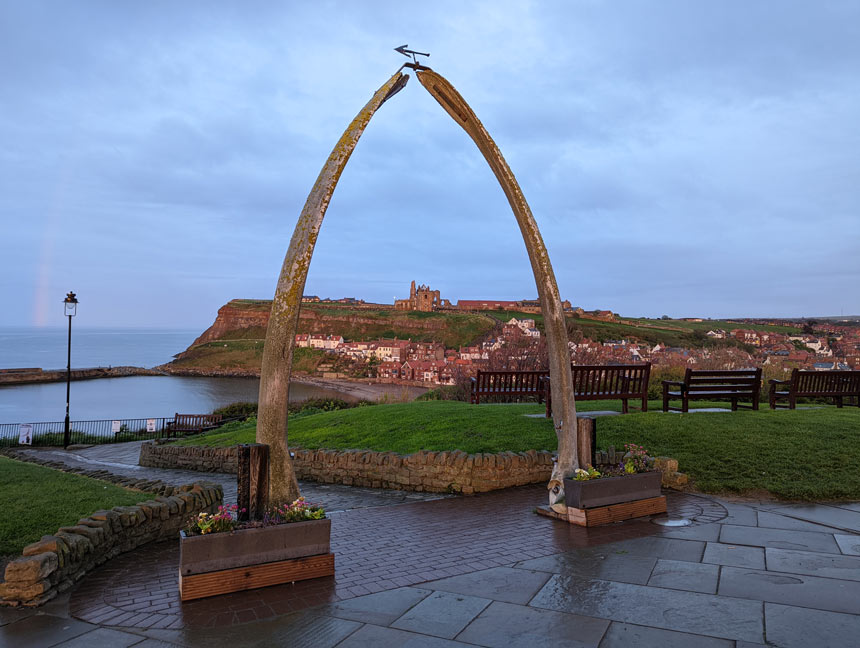
In the 18th and 19th centuries, whaling was an important part of life in Whitby. Ships would set off from the harbour, bound for the Arctic, hoping to return home with a valuable cargo. It was a lucrative but highly dangerous trade which started a Whitby tradition; when ships returned, they tied the bones of the whale’s jaw to their masts to spread the word that they had come back safely and that they had been successful in their mission. The Whale Bone Arch was erected in 1853 to commemorate the tradition.
The whaling industry in Whitby is thankfully long gone, but the Whale Bone Arch remains, perfectly framing the lovely view. The bones you see today aren’t the originals, in fact they’re actually the third set to be placed on the site.
Explore the narrow streets
One of the most charming things to do in Whitby is just to explore the town’s narrow and characterful streets. On the eastern side of the river, visiting Whitby still feels like visiting a fishing village, albeit one with more than its fair share of cafes, galleries and jewellery shops. The red roofs of the fishermen’s cottages tumble down towards the harbour, while alleys with names like Arguments Yard. While you’re in the old town, don’t miss the Old Town Hall and its tiny market square.
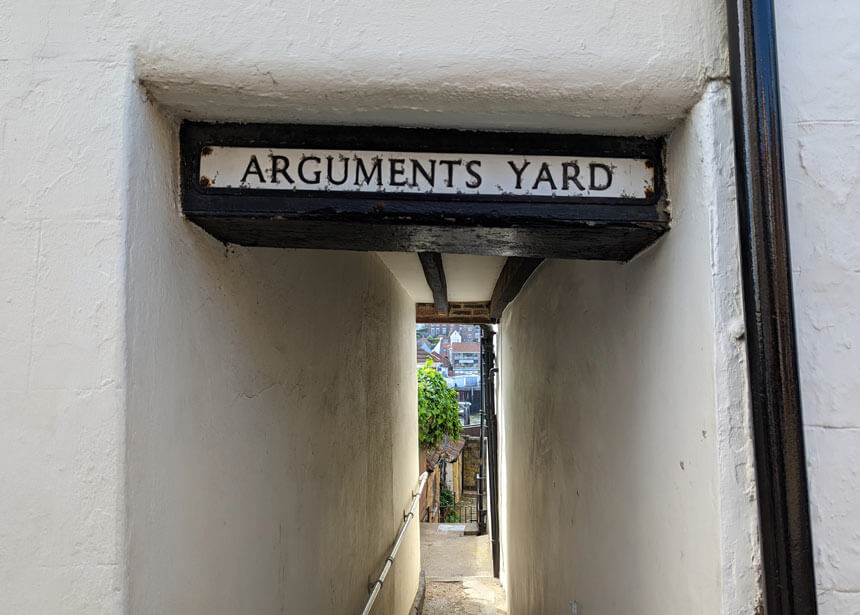
Visiting Whitby’s West Cliff feels very different to the other side of the river. This part of town largely grew up when the railway arrived, bringing Victorian tourists to this picturesquely Gothic seaside town. These tourists needed places to stay, so streets like the Esplanade, North and East Terrace and the Royal Crescent sprang up to accommodate hotels and guesthouses (Bram Stoker stayed at Number 6 Royal Crescent). One of the great things about Whitby is that you can visit two types of seaside destination in a single trip.

Have a pint in a cosy pub
Whitby is full of cosy, historic pubs. Take a seat by the fire and take in an atmosphere that hasn’t changed for generations. The White Horse and Griffin (which dates back to 1681), the Granby and the Endeavour are all favourites with visitors to Whitby – all are dog-friendly and at the Endeavour you can even bring your own fish and chips. My favourite, the Duke of York, which is at the bottom of the 199 steps has just reopened after a refurbishment but it doesn’t look to have lost any of its character.

The Whitby Brewery‘s taproom, right next to Whitby Abbey at the top of the 199 steps is a newer addition to the Whitby pub scene. You can get a pizza to go with your pint, and there’s often live music at weekends. There are occasional brewery tours between Easter and Halloween – check dates and book online in advance.
Take a ride on a steam train
The North Yorkshire Moors Railway is one of Britain’s most scenic heritage railways. The railway runs for 18 miles through beautiful countryside and moorland using locomotives and carriages that hark back to the days when the line was part of the main railway network. While not all trains are hauled by steam locomotives, many are, and it makes for a really special experience.
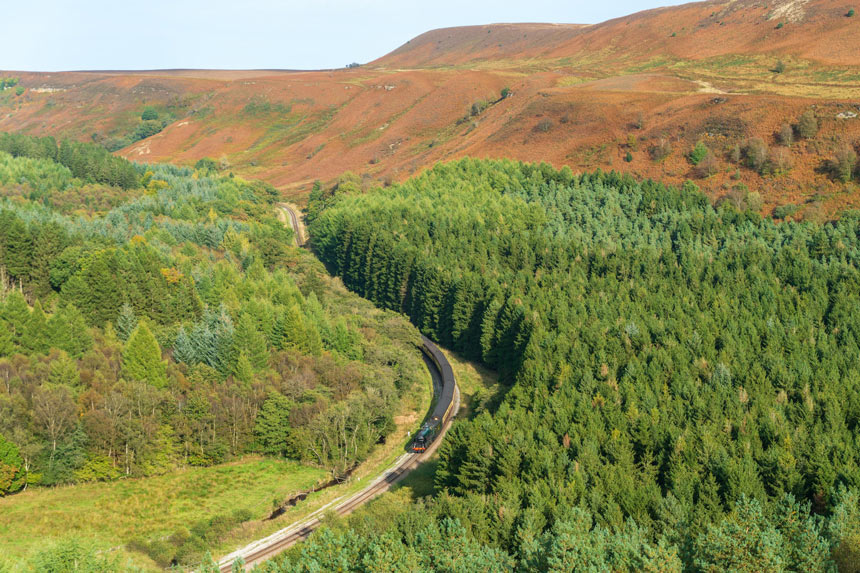
The stops along the line are wonderful to visit in their own right. Pickering, at the end of the line from Whitby is a lovely Yorkshire market town with a 13th-century castle; if you’ve bought an English Heritage pass or membership, visiting Pickering Castle is free. Levisham station is great for walking, and there’s a camping coach where you can stay overnight.
Goathland is particularly lovely, and is popular with people visiting Whitby and the surrounding area as it featured in the first Harry Potter film and the British TV series Heartbeat. At Grosmont, the North Yorkshire Moors Railway connects with the main national railway network; some off-peak trains terminate here while most others continue into Whitby itself.
Explore Whitby’s association with Captain Cook
You’ll see references to Captain James Cook all over Whitby, and until Dracula crept onto Bram Stoker’s page, Captain Cook was Whitby’s greatest claim to fame. Cook was a British explorer and Navy captain, famous for his great voyages in the Pacific Ocean between 1768 and 1779 and for probably being the first European to visit Australia and New Zealand. Cook is a pretty controversial figure, not least for the killing of Māori when he reached New Zealand, but his voyages did result in a significant number of geographic and scientific discoveries.
If you’re visiting Whitby to understand more about Captain Cook, your first stop should be the Captain Cook Memorial Museum. The museum describes his connection with Whitby and is located in the house where he used to lodge when he was serving his seafaring apprenticeship on coal ships.
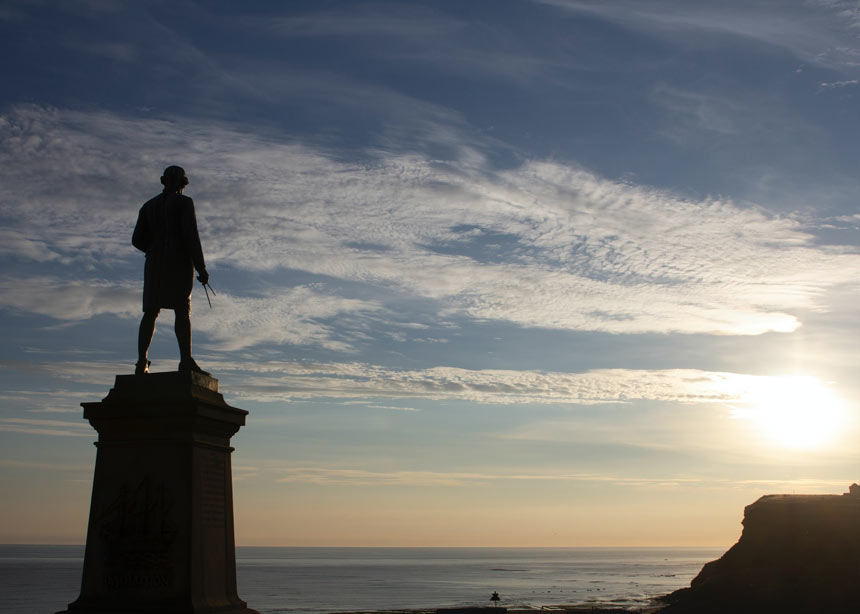
Up on the West Cliff, next to the Whale Bone Arch, there’s a huge bronze statue of Captain Cook looking across the harbour and out to sea. Four of Cook’s ships were built in Whitby, and the inscription on the statue’s base commemorates Cook’s voyages and the ships that took him so far from Whitby.
Take a boat trip
If the North Sea isn’t too rough when you visit, one of the most popular things to do in Whitby is to take a boat trip. There are quite a few options for boat trips, from quick 20-minute trips to see the town from the sea, to longer fishing and wildlife-watching trips.
If you’re lucky, you might also see whales, dolphins or porpoises on your boat trip. The best time of year to see whales and dolphins is June to October, when minke whales and white-beaked dolphins and minke whales follow shoals of fish swimming south from the Arctic.
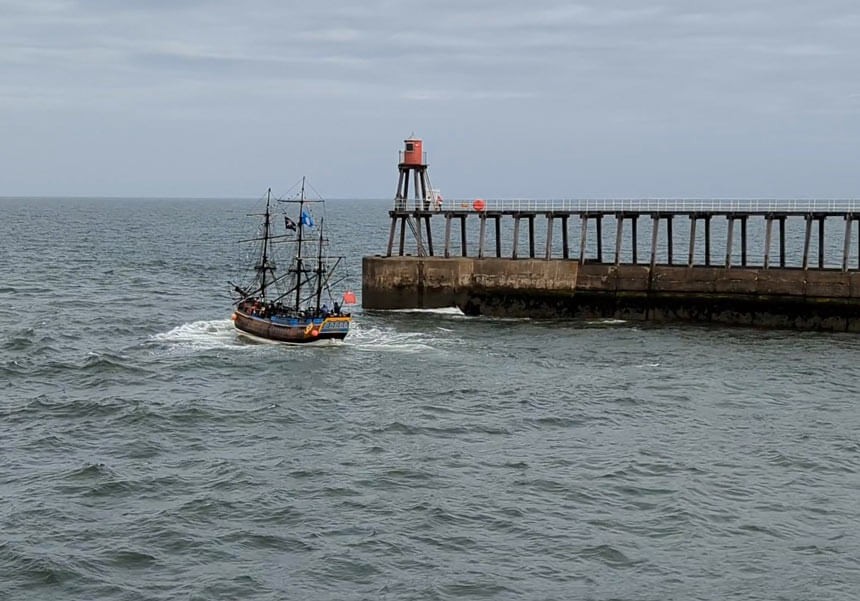
One of the most popular boat trips in Whitby is the Captain Cook Experience, which uses a mini version of Captain Cook’s famous Endeavour sailing ship and sails between April and October. Trips on the Bark Endeavour take you out of Whitby harbour and along the coast towards Sandsend; along the way you’ll hear tales from the sea, sing sea shanties and meet a pirate. It’s great fun for everyone, including kids, if you’ve got the sea-legs for it (I haven’t!).
Go on a ghost tour
One of the best things to do in Whitby in the evening is to go on a ghost walk. When you visit Whitby, you won’t be surprised to learn that it’s home to a significantly higher than average number of ghosts, ghouls and apparitions.
Whitby Abbey has at least two resident ghosts, while next door in St Ann’s churchyard, a ghostly carriage pulled by headless horses and carrying skeletons comes to visit the graves of newly-deceased sailors. Even in the cosy streets of the old town, you’re not safe; watch out for the barghest, a huge, demonic black dog with glowing red eyes – if you hear it howl, your days are numbered.
The most popular Whitby ghost walks are run by ghosthunter Dr Crank. Dr Crank’s walks set off from the Whale Bone Arch and offer either a general introduction to Whitby’s ghosts or a special tour in search of Dracula.
Visit Whitby Museum & Pannett Art Gallery
By now you’ll have realised that Whitby is much more than your average English fishing village. With its seafaring, literary and natural history there’s lots to uncover in Whitby. If you’re interested in Whitby’s history (or if it’s raining – this is the Yorkshire coast after all) then one of the best things to do in Whitby is to visit Whitby Museum and Pannett Art Gallery.
The museum and art gallery are both in Pannett Park, on the west side of the river; the museum covers all things Whitby, from shipbuilding and jet to the history of the Whitby lifeboat and examples of some of the fine fossils that have been found in the area.
The museum’s star exhibit is the Hand of Glory, a severed, pickled human hand that was found in the roof of an old cottage in the 1930s. Hands of Glory were used as bad luck charms in the 16th and 17th centuries; thieves believed that putting a bad luck charm into a house would send the occupants into a coma, making it much easier to loot the contents. The Whitby Hand of God has never been put through DNA or forensic testing, but it’s believed to be that of a man, possibly one who was hanged for a crime. If you’re visiting Whitby, don’t miss seeing this ghoulish curio – it’s entirely on-brand for Whitby!
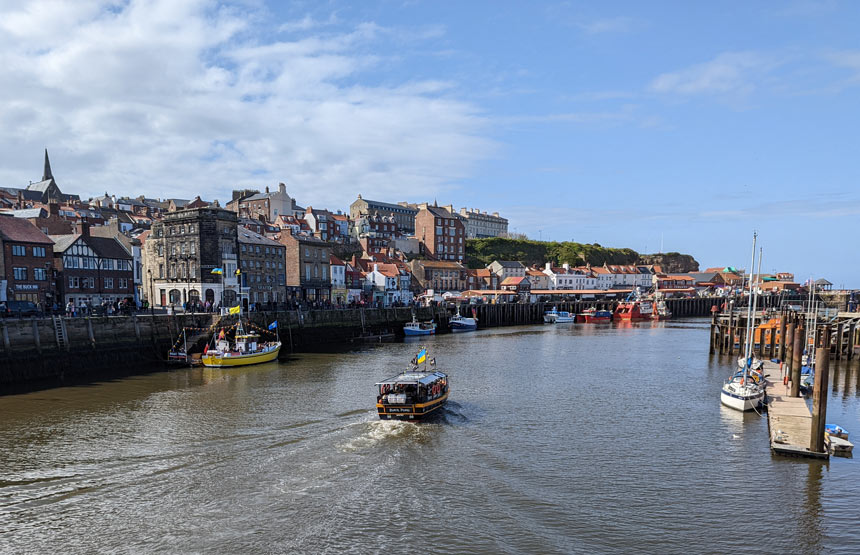
The Pannett Art Gallery is an altogether more chilled out experience. The gallery houses paintings by the Staithes group of artists around the end of the 19th century and the beginning of the 20th. The Staithes group, named for a fishing village just up the coast from Whitby, painted impressionistic scenes from local life, documenting what it was like to live in the area.
Cycle along the coast
Whitby is a great base for visiting the lovely fishing villages of Staithes and Runswick Bay to the north and Robin Hood’s Bay to the south. They’re connected by the Cinder Track, a walking and cycle path which runs for 21 miles along the old Whitby to Scarborough railway line.
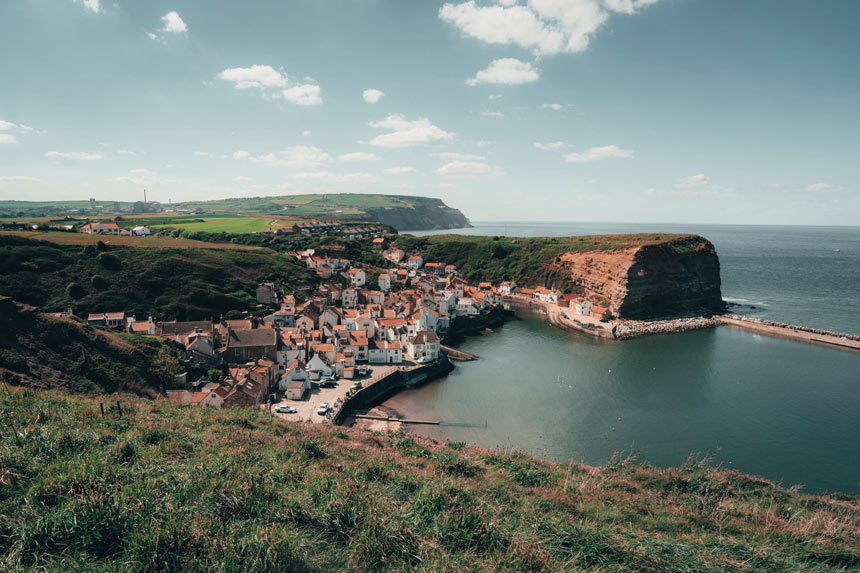
The villages are really popular places to visit and car parking is limited, so it can be nicer to cycle there, especially since, being an old railway line, it’s mostly flat and any slopes are fairly gentle. Bayhire cycle hire in Scarborough offer a range of delivery and collection services if you’re staying in Whitby; they also have e-bikes capable of cycling the full route.
More places to go when you’re visiting Whitby
One of the best things about visiting Whitby is how close you are to some of Yorkshire’s most beautiful destinations. Once you’ve done all the best things to do in Whitby and visited Staithes and Robin Hood’s Bay, the town makes a brilliant base for exploring the North York Moors National Park, the Yorkshire coast and some gorgeous Yorkshire market towns, such as Pickering, Malton and my favourite, Helmsley.
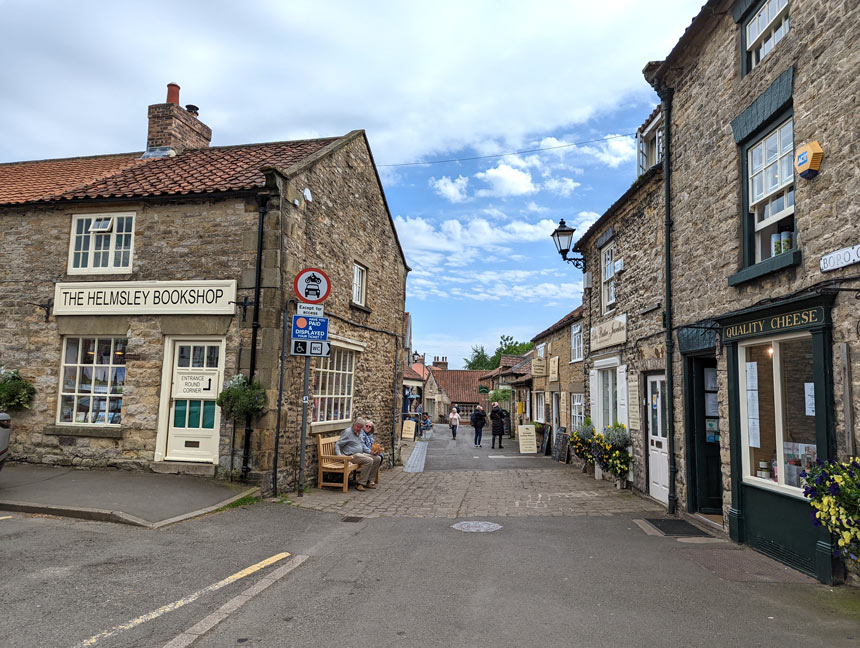
If you can, I really recommend visiting Ravenscar, just south of picturesque Robin Hood’s Bay on the way to Scarborough. Victorian developers had planned for the cliffs at Ravenscar to become a fashionable seaside resort but apart from a hotel and a few other buildings, nothing else was ever built. If you go to Ravenscar today you can see where the streets were supposed to be and see the seals at the bottom of the cliffs who now pretty much outnumber the people.
The Yorkshire coast is particularly fantastic if you’re interested in wildlife. There’s a seal colony at Ravenscar, where you’ll have a good chance of seeing common seal pups in June and July, and grey seal pups in November. I also really recommend visiting RSPB Bempton Cliffs between Filey and Bridlington, where you can watch sea birds, including puffins, nesting on the magnificent chalk cliffs.
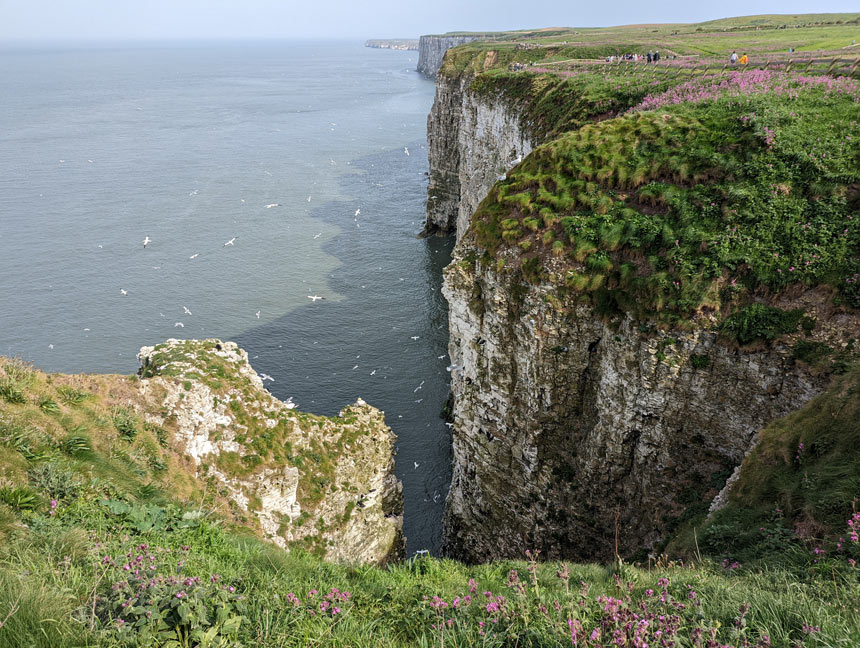
Where to stay in Whitby
If you’re driving to Whitby, I recommend staying on the West Cliff side of the river as you’ve got a better chance of getting parked near your accommodation. We stayed at The Horngarth, which has six rooms on Skinner Street. Our room had an amazing view of Whitby Abbey and we could park the car at the St Hilda’s Terrace car park just a minute away.
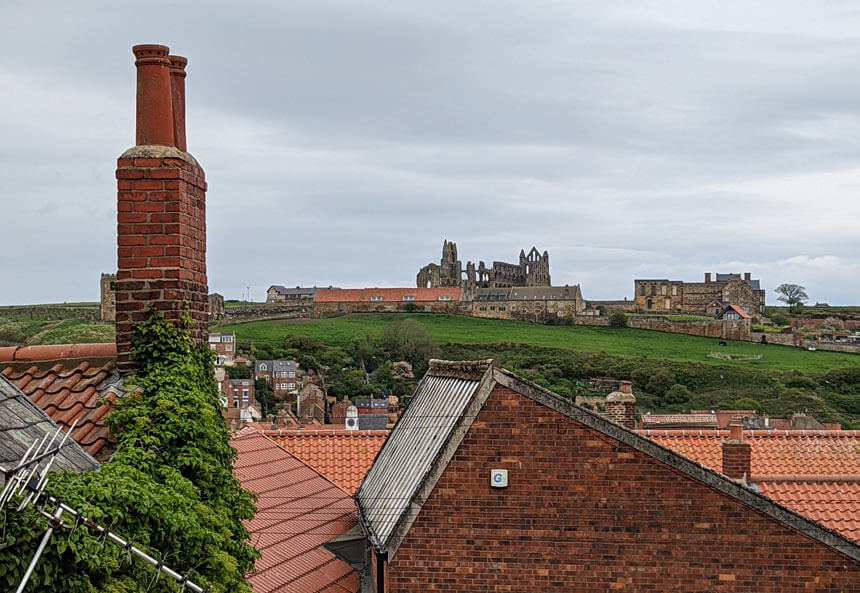
Search for hotels and apartments near Whitby on this map.
How to get to Whitby
Unless you’re coming from Middlesbrough and the north east, in which case you can get the normal train, the easiest way to get to Whitby is by road. This doesn’t necessarily mean by car though!
The Coastliner bus route from Leeds and York to Whitby and Scarborough via Malton and Pickering has been named the most scenic bus route in the UK. You could even take the bus from York to Pickering and then transfer to the North Yorkshire Moors Railway for the final leg to Whitby.
I hope you’ve enjoyed this guide to the best things to do in Whitby. If you’re visiting Whitby soon, please come back and let me know what you enjoyed most!

Amazing guide to Whitby, have picked up so many things to do that you wouldn’t ordinarily find, thank you!
Thanks Tracey, so glad you found it useful!
Really interesting and useful article thank you Helen.
I used the code you gave and have just joined English Heritage for 25% off!!
We are going to Whitby for the week and really looking forward to it.
Thank you Lynn, hope you have a great time in Whitby!
Thank you for these great offerings! My best friend and I are traveling to York in February and will definitely be taking a jaunt over to Whitby.
Thank you Jana, hope you and your friend have a great trip 🙂
Really enjoyed your article – we’re visiting Whitby today so was looking for some inspiration!
Thanks!
Thanks Hanneke, I hope you have a brilliant time in Whitby!
So interesting, planning trip in July. Will print out your many features and visit the lot. Sandra from Australia
Thank you Sandra, I hope you have a wonderful trip to Whitby!